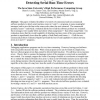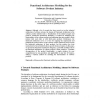EIS
2011
13 years 9 months ago
2011
Most software engineering techniques that deal with software products customization are based on anticipation: The software designer has to foresee, somehow, the future needs for ...
SPLC
2010
14 years 27 days ago
2010
Abstract. Software Product Line (SPL) engineering offers several advantages in the development of families of software products. There is still a need, however, for better underst...
JSA
2008
14 years 2 months ago
2008
Like most software products, protocols are continuously enhanced and new protocols are developed. But especially new protocols of the transport layer can not be utilized widely ea...
CONCURRENCY
2006
14 years 2 months ago
2006
: This paper evaluates the ability of a variety of commercial and non-commercial software products to detect serial run-time errors in C and C++ programs, to issue meaningful messa...
ASE
2006
14 years 2 months ago
2006
Commercial-off-the-shelf (COTS) software tends to be cheap, reliable, and functionally powerful due to its large user base. It has thus become highly desirable to incorporate COTS ...
DIMVA
2009
14 years 3 months ago
2009
Abstract. Many systems have been introduced to detect software intrusions by comparing the outputs and behavior of diverse replicas when they are processing the same, potentially m...
ECSA
2010
Springer
14 years 3 months ago
2010
Springer
Although a lot of research has been carried out on the technical architecture of software systems, the domain of Functional Architecture in the software product industry lacks a fo...
SPLC
2007
14 years 3 months ago
2007
Systems such as adaptative and context–aware ones must adapt themselves to changing requirements at runtime. Modeling and implementing this kind of systems is a difficult opera...
QNS
1996
14 years 3 months ago
1996
This paper suggests a systematic, orderly, process-based approach to stating software quality objectives and knowing if and when they have been achieved. We suggest that quality i...
VAMOS
2010
Springer
14 years 4 months ago
2010
Springer
A product line approach can save valuable resources by reusing artifacts. Especially for software artifacts, the reuse of existing components is highly desirable. In recent literat...




